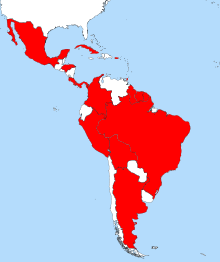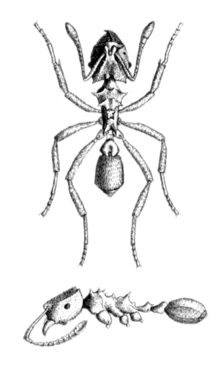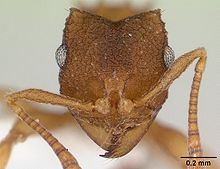- Mycocepurus smithii
-
Mycocepurus smithii 
Specimen of Mycocepurus smithii Scientific classification Kingdom: Animalia Phylum: Arthropoda Class: Insecta Order: Hymenoptera Suborder: Apocrita Superfamily: Vespoidea Family: Formicidae Subfamily: Myrmicinae Tribe: Attini Genus: Mycocepurus Species: M. smithii Binomial name Mycocepurus smithii
(Forel, 1893)
Distribution of Mycocepurus smithii Mycocepurus smithii is an attine fungus-growing ant from Latin America whose species consists exclusively of females which reproduce asexually. The queen reproduces by parthenogenesis and all ants in a colony are female clones of the queen.[1] The ants cultivate a garden of fungus inside their colony grown with pieces of dead vegetables and other insects. It is this capacity for farming which initially prompted research into the species as a basal genus member would provide insight into the natural history of the fungal-cultivating ant tribe, Attini.[2]
Contents
Description
Ants of the genus Mycocepurus are distinctly recognizable for the crown-like cluster of horns on their promesonotum, the fused mesonotum and pronotum on the front of their alitrunk or midsection. M. smithii has sharp, protruding propodeal (posterior of the alitrunk) spines unlike M. obsoletus whose propodeal spines are blunt. Workers also do not have developed promesonotal spines in the center of their crown.[3]
Fungal cultivation
Foundress queens shed their wings prior to colony excavation either near the site or just inside. They then excavate a tunnel to a depth of roughly 10 cm (4 in) and create a primary chamber. The dealate queen then carries the wings into the primary chamber and inserts them into the chamber ceiling where the surface of the wings is used as a platform for growing an incipient fungal garden. The female fore wings of all three Attini basal genera (Mycocepurus, Apterostigma, and Myrmicocrypta) have a crescent-shaped spot lacking any veins or pigmentation, though the spot's functionality is unknown.[2]
Nest architecture
M. Smithii nests in Puerto Rico, Costa Rica, and Trinidad have a single entrance, though the close proximity to other nests in high colony-density areas may give the illusion of multiple entrances.[2] M. Smithii nests consist of a mound excavated around an entrance roughly 1.2 mm in diameter.[4] This leads to a vertical tunnel opening into the garden chamber at a depth of approximately 12.5 mm.[4] M. Smithii maintain narrow tunnels (diameter of 1.3 mm) which do not allow two ants to pass each other in the tunnel (head size is approximately 0.7 mm for workers and 0.9 mm for queens).[2] The tunnels also have a number of slightly larger sections (approximately 3.6 mm diameter) which would allow passing while also facilitating information exchange. Narrow tunnels are presumably easier (energetically cheaper) to construct and may also aide in leveling the humidity or temperature of the colony or preventing predatory intrusions.[2]
Himler research
The research team was led by a graduate student at the University of Texas at Austin in the United States, Anna Himler.[1][5] The researchers initially were interested in the ants' capability for cultivating fungus.[5] The researchers used DNA profiling to confirm that each member of the colony was genetically identical to the queen.[5] They also discovered through a process of dissection that the mussel organ, a female docking apparatus within the vagina used to hook the mate's genitalia,[6] had degenerated in members of this species.[7] A total of six separate tests were carried out, with the researchers unable to locate any male members of the species.[1] The team's findings were then published in the journal Proceedings of the Royal Society B.[7]
References
- ^ a b c Jamieson, Alastair (2009-04-16). "Females get along fine without males - in the world of tropical ants". London: The Telegraph. http://www.telegraph.co.uk/earth/wildlife/5163589/Females-get-along-fine-without-males---in-the-world-of-tropical-ants.html. Retrieved 2009-04-17.
- ^ a b c d e Fernandez-Marin, H.; Zimmerman, J. K.; Wcislo, W. T.; Rehner, S. A. (2005). "Colony foundation, nest architecture and demography of a basal fungus-growing ant, Mycocepurus smithii (Hymenoptera, Formicidae)". Journal of Natural History 39 (20): 1735–1743. doi:10.1080/00222930400027462. http://striweb.si.edu/publications/PDFs/Wcislo_Fernandez%20et%20all%20(2005)(J%20Nat%20Hist).pdf. Retrieved 2009-04-19.
- ^ Mackay, William P.; Maes, Jean-Michel; Fernández, Patricia Rojas; Luna, Gladys; (2004-08-24). "The ants of North and Central America: the genus Mycocepurus (Hymenoptera: Formicidae)". The Journal of Insect Science 4: 27. ISSN 1536-2442. PMC 1081568. PMID 15861242. http://www.insectscience.org/4.27/. Retrieved 2009-04-20.
- ^ a b Fernández-Marín, H; Zimmerman, J.K.; Wcislo, W.T. (2004). "Ecological traits and evolutionary sequence of nest establishment in fungus-growing ants (Hymenoptera, Formicidae, Attini)". Biological Journal of the Linnean Society 81: 39–48. doi:10.1111/j.1095-8312.2004.00268.x. http://si-pddr.si.edu/dspace/bitstream/10088/3672/1/Fernandez_and_Wcislo.pdf. Retrieved 2009-04-20.
- ^ a b c "Ants inhabit 'world without sex'". BBC News. 2009-04-15. http://news.bbc.co.uk/2/hi/science/nature/7998931.stm. Retrieved 2009-04-17.
- ^ Baer, Boris; Boomsma, Jacobus J. (2006). "Mating Biology of the Leaf-Cutting Ants Atta colombica and A. cephalotes". Journal of Morphology 267 (10): 1165–1171. doi:10.1002/jmor.10467. PMID 16817214. http://www1.bio.ku.dk/forskning/oe/cse/media/baerboomsma2006_jmorphology.pdf. Retrieved 2009-04-19.
- ^ a b Himler AG, Caldera EJ, Baer BC, Fernández-Marín H, Mueller UG (2009). "No sex in fungus-farming ants or their crops". Proc R Soc B 276 (1667): 2611. doi:10.1098/rspb.2009.0313. PMC 2686657. PMID 19369264. http://www.pubmedcentral.nih.gov/articlerender.fcgi?tool=pmcentrez&artid=2686657. Lay summary – BBC News (2009-04-15).
Further reading
- Anna Grace Himler, Ph.D. Dissertation: Evolutionary Ecology and Natural History of Fungus-Growing Ants: Host-Switching, Divergence, and Asexuality. Chapter 3. No sex in fungus-farming ants or their crops, 2007.
External links
Categories:
Wikimedia Foundation. 2010.


